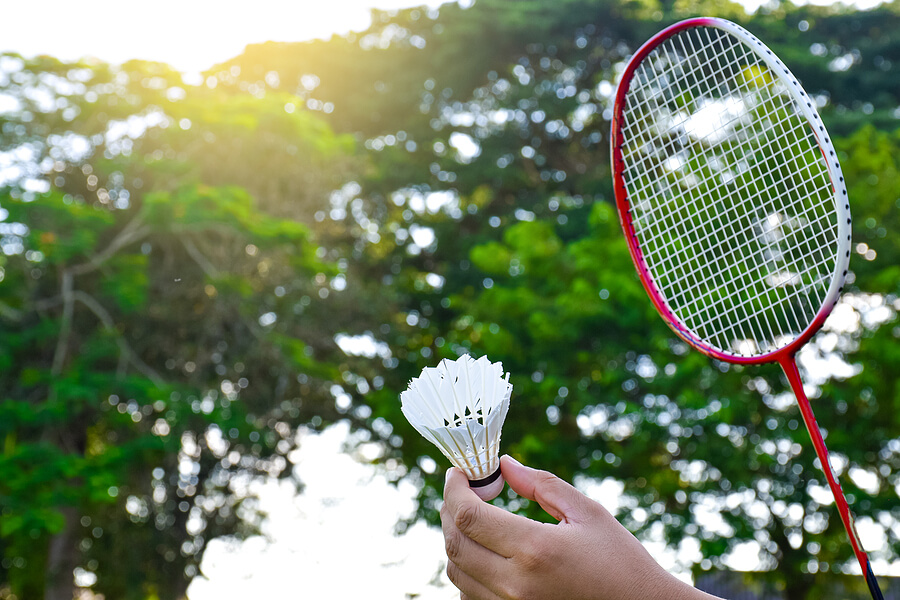Badminton Shuttlecocks: The Key Types And Their Aerodynamics

Who recalls playing a random game of badminton at the void deck or the drop-off area below your HDB? A gentle breeze could not stop you from enjoying a game or two. Even the shuttlecock you used did not matter, too, as long as it was playable enough to bounce off your rackets.
In badminton, the shuttlecock is a tiny, round cork with plastic or feathers attached to it. The aim of the game is to volley it across the net to your opponent with your racket. A typical badminton game employs the use of a feather shuttlecock. However, there are other variations of shuttlecock: nylon and hybrid. Let us dive into the three key types of shuttlecocks!
1. Feather shuttlecocks
The shuttlecock is made up of at least 16 duck or goose feathers overlapping one another on a rounded cork. The feather shuttlecocks are usually used in intermediate to professional training or competition. With the adequate approach, ability, and knowledge, players are able to alter the shuttlecock’s return angle (slicing) or spin the shuttlecock to attack. When compared to the other two shuttlecocks, feather shuttlecocks do not last as long as their counterparts. With poor techniques, the feather can easily be damaged, rendering it useless. Hence, they are not recommended for beginners’ use.
2. Nylon shuttlecocks
Instead of using duck or goose feathers, this shuttlecock is made using high-quality nylon. Because of that, it is light and has a reputation for moving at a faster pace as compared to its feathered counterpart. It is also able to last longer. Nylon shuttlecocks are designed to be more durable, fly better, and be more affordable. Because of that, they are highly recommended as training shuttles for beginners and recreational players who do not want to spend too much on buying new shuttles.
3. Hybrid shuttlecocks
The hybrid shuttlecock is essentially a combination of the two. They are a newer development that was made in recent years. They are supposed to allow higher control than nylon shuttlecocks and last longer than feather shuttlecocks.
Now that we have understood the key types of shuttlecocks available in the sport, let us move on to understanding the physics behind how they fly – aerodynamics.
Aerodynamics of shuttlecocks
Aerodynamics is the study of how things interact with air as they move. Everything that moves through the air, from a falcon soaring in the sky to an aeroplane taking off from the ground, is affected by its aerodynamics. Even driving a car involves a great deal of aerodynamics. With that being said, the same principles apply to shuttlecocks, as we will explain in just a bit.
Shuttlecocks do move faster than balls used in various sports. However, they also face higher drag force which causes them to slow down rapidly. The drag force affects where the shuttlecock goes. As such, it also affects how well the player can keep it within the court boundaries.
As mentioned earlier, the feather and nylon shuttlecocks are made differently. As such, in order to replicate the aerodynamic effect of the overlapping feathers on the feather shuttlecock faces, the skirt of the nylon shuttlecock has holes that are “randomly” placed. Nevertheless, both shuttlecocks do have different aerodynamic effects and flight paths. A nylon shuttlecock, being lighter, flies higher and faster but has a shorter flight path as compared to a feather shuttlecock, which is heavier, causing it to fly lower but have a longer flight path.
Many studies have shown that the gaps in the shuttlecock’s skirt lead to increased aerodynamic drag. As a result, a nylon shuttlecock bends more as compared to its feathered counterpart when moving at the same speed. Hence, the reason why they, too, have a shorter flight path than a feather shuttlecock.
Conclusion
Now that you are aware of the physics behind badminton, hopefully, it increases your love for the sport. It might even make you a better player now that you know more about the intricacies of badminton. There is more science to it than you think.
If you are interested to know more about the physics fundamental behind some of the most common elements in our daily life, then look no further than Physics Tuition. Find out more about our tuition classes at http://www.physics.com.sg/.